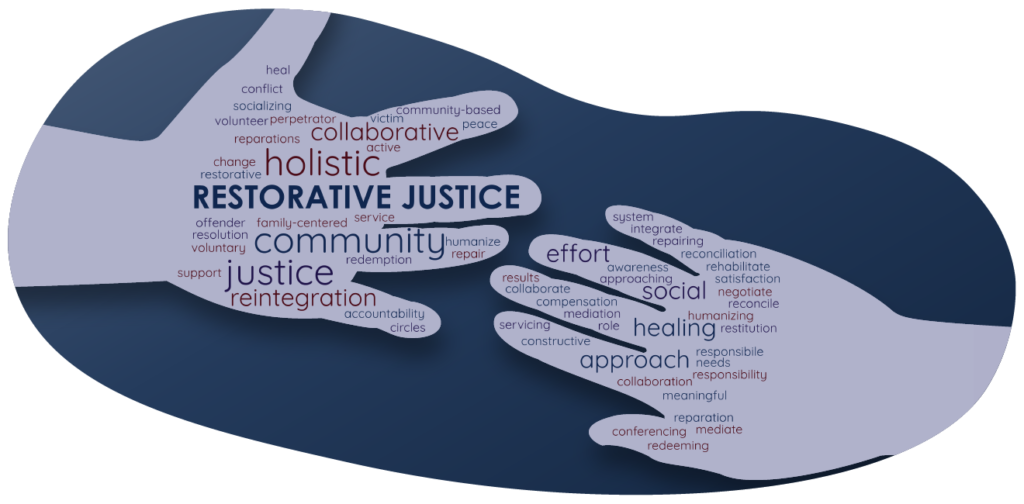Everyone has different ways of healing; there is no one “right way.” Sometimes we find comfort in those around us, and sometimes we simply find comfort in our own homes. While the obvious solution when seeking justice may be to rely on legal institutions, such as prisons or courts, that may be difficult for many. Another option you may not be aware of is restorative justice.
What is Restorative Justice?
Restorative justice (RJ) focuses on repairing the harm caused by looking and thinking about crime using a holistic, collaborative, and humanizing approach. It views crime not only as a violation of the law but also of people, relationships, and communities.
RJ can be requested by victims of a crime; however most programs require the voluntary participation of the offender and that they accept responsibility for their actions. This method of justice holds the offenders responsible for their actions by providing parties affected by the crime an opportunity to address their needs and to seek a resolution that can amend the wrongdoing, thereby preventing further crime, harm, and victimization.
When effectively used, restorative justice can lead to better outcomes for victims and offenders, and reduce the number of cases that go to trial.
How Is Restorative Justice Different From Transformative Justice?
Restorative justice is an alternate model of the justice process where victims, communities and offenders affected by an injustice have an opportunity to discuss how they have been impacted and decide what should be done to repair the harm. Within the RJ model, offenders are asked to acknowledge their crime and attempt to atone for it.
While coming from the same background as restorative justice, transformative justice (TJ) seeks to change the larger social structure as well as the personal structure of those involved. Transformative justice wants to inform victims with answers as to why they were victimized, recognizing the wrong that has occurred, providing restitution, and establishing peace.
Both TJ & RJ concepts are essentially reaching for the same goal. Transformative justice (TJ) is a political framework and approach for responding to violence, harm and abuse. Restorative justice is an approach focused on repairing harm that’s occurred in a community by using techniques that involve all parties; the victim, the offender, their social networks, justice agencies, and the community.
Is Restorative Justice the Right Choice for You?
As with any decision, it is important to explore which option works for you.
Restorative justice can be used with varying programs at multiple stages of the criminal justice process. Please inform yourself on the options available to you before making a decision, as always it is best to consult a legal professional to fully understand the implications before you make a decision.
Most RJ programs are not equipped to deal with serious cases involving power inequalities, such as domestic violence. Some programs have developed partnerships with appropriate supporting agencies to offer RJ in some of these cases, but that is not the norm.
Many of the programs available through RJ require the voluntary participation of the offender and that they accept responsibility for their actions. Some, but not all programs, require the participation of victims. Programs can take place at different stages of the criminal justice process. For example, some programs may require the offender to plead guilty, others may take place after charges have been laid. Some initiatives take place after conviction, but before sentencing occurs (pre-sentence programs), while others take place after an offender has been sentenced (post-sentence programs).
Below is a list outlining different types of restorative programs available throughout Canada, as provided by the Correctional Service of Canada Dispute Resolution Unit.

Types of Restorative Justice Programs
Victim Offender Mediation Programs (VOMP)
Trained mediators bring victims and offenders together in a safe and structured setting to discuss the crime, its impact, and any agreement to address it. The offender is afforded opportunities to make apologies, provide information, and to develop reparative plans and gain insight for personal growth. More indirect variants also exist where there is instead an exchange of letters or videos between the victim and their offender.
Surrogate Victim/Offender Restorative Justice Dialogue
A victim or an offender may choose to meet with someone who committed a similar crime, or who was similarly victimized, instead of meeting with the specific offender or victim in his or her case. The surrogate victim/offender dialogue has proven beneficial to many victims who want to experience a restorative meeting, but who for whatever reason cannot bring themselves to meet the offender in their case.
Conferencing
The victim, the offender, their supporters, and community members work toward reparation, facilitated by an independent third party.
Victim Panels
A group of victims who speak to an offender about the impact that a crime has had on their lives. Victim-offender panels bring together victims with offenders who have committed a similar crime to that which they have experienced.

Circles
Similar to mediation, however they involve community members such as family in addition to the victim and offender.
Circles of Support and Accountability
Groups of volunteers, often from the faith communities, that form a “covenant” with a released high-risk sex offender. For its part, the Circle helps provide a healthy environment for the ex-offender by advocating with various systems, dialoging the ex-offender about his attitudes and behaviours, and mediating concerns with the community. The victim’s participation is not required.

Peacemaking Circles
Rooted in Aboriginal experience and tradition, this program is based on the belief that the primary responsibility for addressing the problems of crime lies in the community and not just with those directly impacted by the crime and their immediate families. These circles focus on trying to uncover the underlying problems, and to restore balance where possible.
Healing Circles
Ceremonies intend to bring conflict to a close, they allow the participants to express their feelings, and indicate that the offender and victim have undergone personal healing.
Sentencing Circles
The victim, offender, family, and community members, meet with a judge, lawyers, police, and others to recommend to the judge what type of sentence an offender should receive. The victim and the community have the opportunity to express themselves, address the offender, and may also take part in developing and implementing a plan relating to the offender’s sentence.
Community-Assisted Hearings/Releasing Circles
This is available to offenders who are indigenous. This process is similar to a parole hearing in that it occurs within the prison. It differs from a traditional hearing in that all of the participants, including members of the board, the offender, their parole officer, their support person, aboriginal elders from the community, the hearing assistant, and the victims (if they are present) sit in a circle for the purposes of the hearing.

How to Get Connected to a Restorative Justice Program
Referral to RJ programs in Canada can occur at various entry points within the criminal justice system – pre-charge (referral by police), post-charge (crown), pre-sentence (courts), post-sentence (corrections), or pre-revocation (parole).
Accessing Services through the Restorative Opportunities (RO) Program is available to people harmed by the offence requesting to communicate with the offender who caused the harm. Services provided by the RO program are available to registered victims, victim representatives acting on behalf of registered victims, and non-registered victims impacted by the crime.
If you are interested in Restorative Opportunities, you may contact the Restorative Justice Division at 1-877-730-9673 or by email. You can also call CSC’s Victim Services Division toll-free at 1-866-806-2275, where the call will be directed to the appropriate Victim Services Officer.
A directory link to programs available in Canada is below.
Resources:
https://www.justice.gc.ca/eng/cj-jp/rj-jr/sch-rch.aspx
https://www.sace.ca/learn/transformative-restorative-justice/
https://www.csc-scc.gc.ca/restorative-justice/003005-1000-eng.shtml
https://www.victimsfirst.gc.ca/res/pub/gfo-ore/pdf/RestorativeJustice.pdf
http://www.csc-scc.gc.ca/text/rj/crg-eng.shtml
http://www.rjlillooet.ca/documents/restjust.pdf
https://restorativejustice.org/rj-archive/restorative-justice-and-transformative-justice-definitions-and-debates/
Legal Disclaimer:
Our website provides general information that is intended, but not guaranteed, to be correct and up-to-date. The information is not presented as a source of legal advice. You should not rely, for legal advice, on statements or representations made within the website or by any externally referenced Internet sites. If you need legal advice upon which you intend to rely in the course of your legal affairs, consult a competent, independent attorney. Vesta Social Innovation Technologies does not assume any responsibility for actions or non-actions taken by people who have visited this site, and no one shall be entitled to a claim for detrimental reliance on any information provided or expressed.
